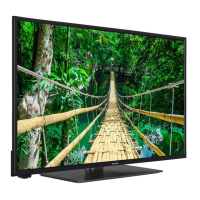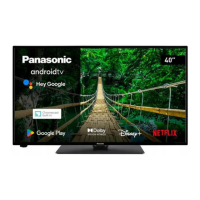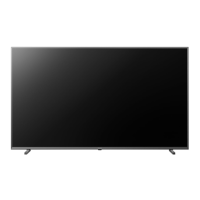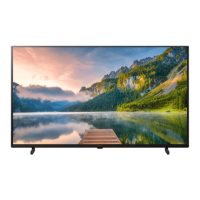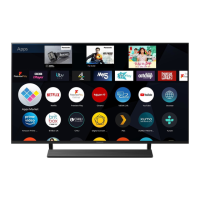Do you have a question about the Panasonic TX-40MS360B and is the answer not in the manual?
Explanation of symbols used on the product for restrictions and safety instructions.
Instructions for cleaning the display panel, cabinet, and mains plug.
Guidelines for gently wiping and cleaning the TV's surfaces.
Instructions for cleaning the mains plug to prevent fire or shock.
Use the TV as a digital picture frame in standby mode.
Information on TV standby notifications for no signal or auto power down.
Using the remote control for menu navigation and selection.
Switching between different external input sources.
Changing channels and adjusting volume using remote buttons.
Using the standby button for reset, normal standby, or forced power off.
Customize and navigate the main TV menu for quick access.
Search for channels, apps, web content, and videos.
Access Guide, Channels, and other TV-specific features.
Set timers, manage installed apps, and access the app market.
Configure accessibility options and manage privacy privileges.
Adjust system preferences and manage input sources.
Control TV power states using the standby button.
Using directional buttons, OK, and Exit for menu interaction.
Control media playback with play, pause, stop, and navigation buttons.
Access Freeview Play, Netflix, and custom buttons.
Connect devices via VGA, HDMI, and AV inputs.
Connect external audio systems and headphones.
Connect USB devices and Common Interface modules.
Connect to the network using an Ethernet cable.
Procedure for turning the TV on from standby or hard standby.
Understanding and using different TV standby modes.
Scan for digital terrestrial and cable broadcasts.
Configure direct, single cable, or DiSEqC satellite connections.
Scan for analogue broadcasts.
Control playback order for media files.
Personalize the TV boot screen with a custom image.
Control CEC-enabled devices connected via HDMI.
Output TV audio to external systems via HDMI ARC.
Manage TV settings for remote, sharing, timer, CEC, and auto power.
Adjust picture mode, contrast, brightness, sharpness, colour, energy saving, backlight, zoom.
Enable or disable the virtual remote feature for smartphone control.
Share files from smartphone/tablet to TV via network.
Configure power saving modes including Custom, Minimum, Medium, Maximum, Auto, Screen Off.
Fine-tune picture with dynamic contrast, colour temperature, and white point.
Enhance white colour and local contrast for brighter pictures.
Reduce picture noise and improve motion clarity for films.
Adjust colour tone, hue, and manage colour range.
Enhance blackness in HDMI source and reset picture settings.
Configure Dolby Audio processing and surround sound modes.
Select sound output and control automatic volume limiting.
Adjust equalizer modes and enable dynamic bass.
Configure headphone volume and sound balance.
Configure wired or wireless network connections.
Scan for networks, connect, and manage wireless profiles.
Enable or disable TV wake-up via network message.
Scan for channels using automatic tuning or direct entry.
Configure satellite antenna settings and perform scans.
Clear, select, or manage stored channels.
Adjust contrast and enable hearing assistance features.
Enable audio description and improve dialogue clarity.
Configure spoken subtitles and screen magnification.
Highlight programming with specific access services.
Manage privacy preferences for smart TV applications.
Set PIN, menu locks, and content restrictions.
Configure date, time, and manage source names.
Configure Alexa and Google Assistant for voice control.
Set auto standby timer and select subtitle display.
Configure power up preference and view software licenses.
Set app priority and view device model information.
Edit, filter, and set favourite channels.
Create and manage up to four favourite channel lists.
Set parental locks for menus, channels, and internet access.
Browse current and upcoming TV schedules.
View TV schedules in timeline or now/next format.
Set timers for events and access event details.
Access catch-up TV services via Freeview Play.
Access digital, MHEG, and BBC Red Button+ teletext.
Resolve problems with the TV not turning on or poor picture quality.
Troubleshoot no sound or remote control operation issues.
Address no signal errors and VGA image centering problems.
List of video file extensions, codecs, and resolution support.
List of image file extensions and resolution support.
List of audio file extensions and formats supported.
Connect the TV to a network using an Ethernet cable.
Test connection speed and configure IP/DNS settings.
Connect the TV to a wireless network.
Select network type and scan for available wireless networks.
Connect using WPS and test internet speed.
Connect mobile devices via WLAN for content sharing.
Manage personal data collection and privacy policies.
Enable or disable TV wake-up via network messages.
Troubleshoot wireless connection problems.
Address slow internet or playback disruptions.
Use AVS standard for viewing media on home network.
Steps to enable and play shared files via Media Browser.
Manage installed apps and add new ones from the market.
Introduction to catch-up TV and On Demand services.
Find shows meeting accessibility needs and filter content.
Navigate websites, manage Speed Dial, and use browser features.
Understand Hybrid Broadcast Broadband TV services.
Set up Alexa for voice control and configure Home Screen.
Link TV to Amazon account for Alexa control.
Link TV to Google account for voice assistant control.
Voice commands for controlling TV functions.
Correct wiring procedures for the mains lead.
Guidelines for fuse replacement and general safety.
Explanation of symbols used on the product for restrictions and safety instructions.
Instructions for cleaning the display panel, cabinet, and mains plug.
Guidelines for gently wiping and cleaning the TV's surfaces.
Instructions for cleaning the mains plug to prevent fire or shock.
Use the TV as a digital picture frame in standby mode.
Information on TV standby notifications for no signal or auto power down.
Using the remote control for menu navigation and selection.
Switching between different external input sources.
Changing channels and adjusting volume using remote buttons.
Using the standby button for reset, normal standby, or forced power off.
Customize and navigate the main TV menu for quick access.
Search for channels, apps, web content, and videos.
Access Guide, Channels, and other TV-specific features.
Set timers, manage installed apps, and access the app market.
Configure accessibility options and manage privacy privileges.
Adjust system preferences and manage input sources.
Control TV power states using the standby button.
Using directional buttons, OK, and Exit for menu interaction.
Control media playback with play, pause, stop, and navigation buttons.
Access Freeview Play, Netflix, and custom buttons.
Connect devices via VGA, HDMI, and AV inputs.
Connect external audio systems and headphones.
Connect USB devices and Common Interface modules.
Connect to the network using an Ethernet cable.
Procedure for turning the TV on from standby or hard standby.
Understanding and using different TV standby modes.
Scan for digital terrestrial and cable broadcasts.
Configure direct, single cable, or DiSEqC satellite connections.
Scan for analogue broadcasts.
Control playback order for media files.
Personalize the TV boot screen with a custom image.
Control CEC-enabled devices connected via HDMI.
Output TV audio to external systems via HDMI ARC.
Manage TV settings for remote, sharing, timer, CEC, and auto power.
Adjust picture mode, contrast, brightness, sharpness, colour, energy saving, backlight, zoom.
Enable or disable the virtual remote feature for smartphone control.
Share files from smartphone/tablet to TV via network.
Configure power saving modes including Custom, Minimum, Medium, Maximum, Auto, Screen Off.
Fine-tune picture with dynamic contrast, colour temperature, and white point.
Enhance white colour and local contrast for brighter pictures.
Reduce picture noise and improve motion clarity for films.
Adjust colour tone, hue, and manage colour range.
Enhance blackness in HDMI source and reset picture settings.
Configure Dolby Audio processing and surround sound modes.
Select sound output and control automatic volume limiting.
Adjust equalizer modes and enable dynamic bass.
Configure headphone volume and sound balance.
Configure wired or wireless network connections.
Scan for networks, connect, and manage wireless profiles.
Enable or disable TV wake-up via network message.
Scan for channels using automatic tuning or direct entry.
Configure satellite antenna settings and perform scans.
Clear, select, or manage stored channels.
Adjust contrast and enable hearing assistance features.
Enable audio description and improve dialogue clarity.
Configure spoken subtitles and screen magnification.
Highlight programming with specific access services.
Manage privacy preferences for smart TV applications.
Set PIN, menu locks, and content restrictions.
Configure date, time, and manage source names.
Configure Alexa and Google Assistant for voice control.
Set auto standby timer and select subtitle display.
Configure power up preference and view software licenses.
Set app priority and view device model information.
Edit, filter, and set favourite channels.
Create and manage up to four favourite channel lists.
Set parental locks for menus, channels, and internet access.
Browse current and upcoming TV schedules.
View TV schedules in timeline or now/next format.
Set timers for events and access event details.
Access catch-up TV services via Freeview Play.
Access digital, MHEG, and BBC Red Button+ teletext.
Resolve problems with the TV not turning on or poor picture quality.
Troubleshoot no sound or remote control operation issues.
Address no signal errors and VGA image centering problems.
List of video file extensions, codecs, and resolution support.
List of image file extensions and resolution support.
List of audio file extensions and formats supported.
Connect the TV to a network using an Ethernet cable.
Test connection speed and configure IP/DNS settings.
Connect the TV to a wireless network.
Select network type and scan for available wireless networks.
Connect using WPS and test internet speed.
Connect mobile devices via WLAN for content sharing.
Manage personal data collection and privacy policies.
Enable or disable TV wake-up via network messages.
Troubleshoot wireless connection problems.
Address slow internet or playback disruptions.
Use AVS standard for viewing media on home network.
Steps to enable and play shared files via Media Browser.
Manage installed apps and add new ones from the market.
Introduction to catch-up TV and On Demand services.
Find shows meeting accessibility needs and filter content.
Navigate websites, manage Speed Dial, and use browser features.
Understand Hybrid Broadcast Broadband TV services.
Set up Alexa for voice control and configure Home Screen.
Link TV to Amazon account for Alexa control.
Link TV to Google account for voice assistant control.
Voice commands for controlling TV functions.
Correct wiring procedures for the mains lead.
Guidelines for fuse replacement and general safety.
| Display Technology | LED |
|---|---|
| Smart TV | Yes |
| HDMI Ports | 3 |
| USB Ports | 2 |
| Audio Output | 20W |
| Wi-Fi | Yes |
| Ethernet Port | Yes |
| Bluetooth | No |
| Screen Size | 40 inches |
